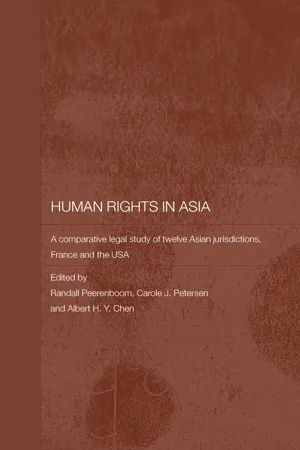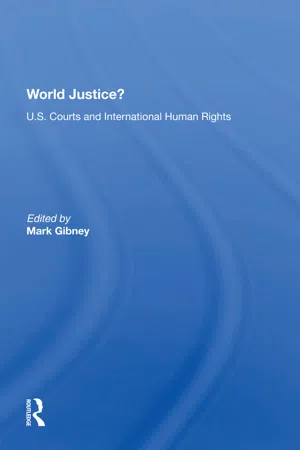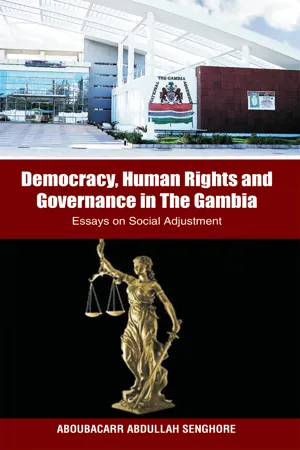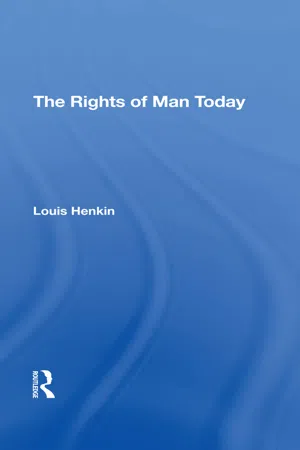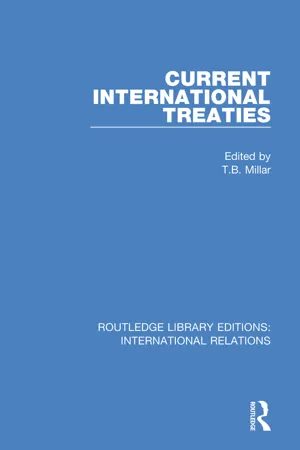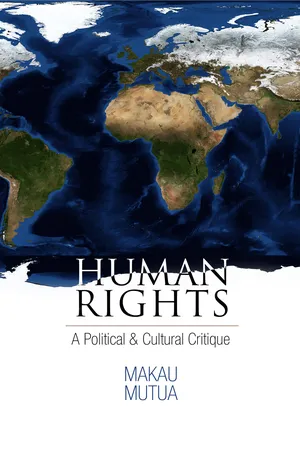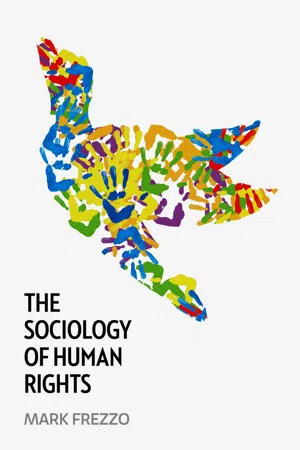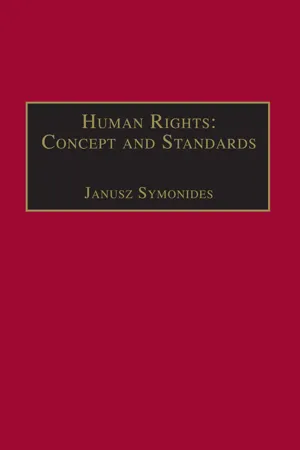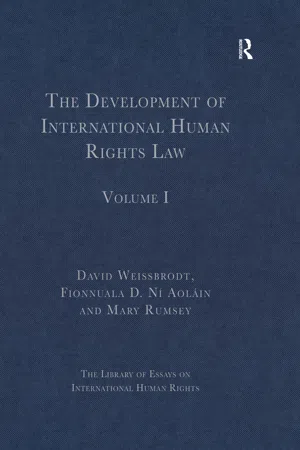Law
US Human Rights
US human rights refer to the fundamental rights and freedoms guaranteed to individuals by the US Constitution and international human rights treaties. These rights include civil and political rights, such as freedom of speech and the right to a fair trial, as well as economic, social, and cultural rights, such as the right to education and healthcare. The US government is responsible for upholding and protecting these rights for all individuals within its jurisdiction.
Written by Perlego with AI-assistance
Related key terms
10 Key excerpts on "US Human Rights"
- eBook - ePub
Human Rights in Asia
A Comparative Legal Study of Twelve Asian Jurisdictions, France and the USA
- Randall Peerenboom, Carole J. Petersen, Albert H.Y. Chen, Randall Peerenboom, Carole J. Petersen, Albert H.Y. Chen(Authors)
- 2006(Publication Date)
- Routledge(Publisher)
Individual states and even localities within states have their own constitutions and laws that guarantee a multiplicity of rights, often to a greater extent than the federal Constitution or other federal laws. However, the focus of the chapter will remain squarely on federal legal guarantees of human rights and the jurisprudence of federal courts, especially of the Supreme Court.Two final aspects should be borne in mind in any assessment of human rights laws in the USA, both of which constitute broader societal aspects. The first is the familiarity of ordinary citizens with their constitutional rights and moreover, their willingness and ability to litigate in order to exercise these rights. The decisions of the Supreme Court, especially on issues relating to the civil and political rights guaranteed in the Bill of Rights, are widely disseminated and discussed in the media and sometimes generate intense responses from the public in the form of mass mailings to the Supreme Court, demonstrations or the lobbying of government representatives to change decisions. Second, however, it is the view of some “liberal” or “leftist” commentators that certain institutional factors – most notably the dominance of the capitalist economic model in the USA and the resulting concentration of wealth and media ownership in the hands of a relative few – pose substantial obstacles to the realization of human rights in the USA.5 These include obstacles to influencing mainstream public discourse on rights, as well as to realizing economic, social, and cultural rights.Civil and political rights in the USA
Constitutional aspects: Bill of Rights
Reflecting libertarian ideology, the rights enumerated in the Bill of Rights are only guaranteed against governmental interference and are generally not guaranteed against the acts of non-state - eBook - ePub
World Justice?
U.S. Courts And International Human Rights
- Mark Gibney(Author)
- 2021(Publication Date)
- Routledge(Publisher)
5International Human Rights Law and U.S. LawDOI: 10.4324/9780429268038-5John M. RogersBecause of the often imprecise use of the term "human rights," along with widespread misunderstanding of the relationship between international law and domestic law, it is not surprising that the subject of enforcement of human rights in United States courts is confusing. Unfortunately, the confusion may lead some who are most vigorously opposed to human rights violations to advocate legal positions that in the long run do little to advance human rights, and that may harm other important policy considerations. Some lawyers argue, for instance, that the public international law of human rights is directly applicable law in United States courts, just like the United States Constitution.1 What follows is a modest attempt to clarify the subject, with the hope that this may to some extent serve to channel human rights advocacy in directions most likely to be effective.Definitions
It is helpful at the outset to think of human rights as limits on the ways that governments interact with people. It is of course possible to conceive of human rights more broadly. For instance, every obligation of any sort to a person, whether from another person, from a private organization, from a government, or even from God, could effect a "right," and by virtue of the fact that the obligation is to a person, the right could be called a "human right." Such a definition would not be very useful; it would incorporate much of law as we know it: public law, private law, even religious law, and maybe even systems of moral obligations. For instance, if Terry promised Leslie never to lie to Leslie, we might say that Leslie has a right not to be lied to by Terry. By virtue of the fact that Leslie is a person, we might call this a "human right," even though Leslie has no legal right never to be lied to, and even though the lie may not be very significant. The definition is not useful because it is too broad: any discussion of enforcement, for instance, would comprehend the entire subject of ethics. We would simply have to create a subset of "human rights" in order to discuss the kinds of protections commonly associated with the idea of "human rights." - eBook - ePub
Democracy, Human Rights and Governance in The Gambia:
Essays on Social Adjustment
- Abdullah Senghore(Author)
- 2018(Publication Date)
- CENMEDRA(Publisher)
30 Finally, a closer look at the five fundamental values that, according to Muslim jurists, Shariah has been revealed to protect and preserve, clearly shows that Islamic law has in actual fact adequately guaranteed the protection and ensured the means of actualization of all fundamental human rights and basic freedoms incorporated in the international human rights conventions and treaties of contemporary times i.e. the protection of life, religion, intellect, progeny and property has definitely included all the civil, political, economic, social and cultural rights protected by the modern international law of human rights and various national laws of the nation states of contemporary times.I.d. Can the Concept of Human Rights be Universally and Comprehensively Defined? And What Significance will that Definition Make?As the above discussion of the nature of rights reveals there can be no single universal and comprehensive definition for the concept of human rights. The various philosophical perspectives just highlighted above stand to contradict one another. So to give a single definition comprehensive enough to be accepted by all is out of the question. Similarly, the continuing debate and controversy between the theories of universality and cultural relativism over the scope and relevance of human rights is another factor ruling out the possibility of providing such a definition. While any definition by the proponents of the universality theory would stress the universal, indivisible, interdependent and interrelated character of human rights and that they have to be placed beyond the limits of domestic jurisdiction, the cultural relativists would advance a definition which emphasizes the need to consider human rights in their ideological, regional and national context and on the principle of respect for and non interference in the internal affairs of a sovereign state. However, given that the concept or term “rights” is used to describe a variety of relationships the following description of the concept may be recognized (although it sounds influenced by the theory of natural rights): Human Rights are those fundamental values inherent in every individual human being on the basis of humanity and recognized by law both domestic and international. - eBook - ePub
- Louis Henkin(Author)
- 2019(Publication Date)
- Routledge(Publisher)
TwoConstitutions and Human RightsHuman rights are now established in conception and principle and are national and international law for many nations. There is common agreement that every individual has both political-civil and economic-social claims upon his society. But in a world of nation-states, the strength of commitment to human rights and the extent to which it is realized depend on the particular state and its institutions; the condition of human rights thus differs markedly in different societies. Some states, and some groupings of states, are identified by differing ideologies connoting different conceptions and commitments to human rights.These differences are reflected or signaled in large measure in national constitutions. Constitutions, to be sure, are at best promises, and constitutional promises often remain unfulfilled. But what a constitution promises tells us, at least, what a society pretends or aspires to, where individual rights stand in its political system and scale of values, and much about how rights fare in fact.In the American conception, a constitution is an instrument that “constitutes” a government and prescribes the blueprint for that government, as the sovereign people of the United States ordained the Constitution of the United States constituting the government described therein. (“The British Constitution” is not in one document but refers to the system of government constituted by historic development and by several acts and documents emanating from recognized authority.) Because it was assumed—especially under theories of popular sovereignty—that the government constituted would be limited, because the U.S. and other constitutions in fact imposed limitations on government, a constitution (and “constitutionalism”) came to imply limited government. Because protecting the people’s liberties was seen as the principal reason for limitation and because a principal limitation in constitutions was a bill of rights, constitutionalism became identified with respect for individual rights.1 - eBook - ePub
- T B Millar(Author)
- 2015(Publication Date)
- Routledge(Publisher)
Chapter 7 Human RightsThe notion of individual or group rights, whether codified or not, is as old as government. The obligations required of members of a society carried with them something in return, expectations that the authority upheld would assume the provision of food and clothing, or the allocation of land, the protection of life and property. Human rights, or rights as citizens, were codified in some of the Greek city states, and in Western culture doctrines about human or natural rights stemmed from that period. Rights accumulated through custom and law. Bills of Rights became enacted or embodied in state constitutions from 1689 onwards—initially in Britain, then in the United States, France, and elsewhere. Internationally, the codification of human rights began after World War II, a war in which the rights of religious or other minorities were so widely and deeply disadvantaged. Unlike the Covenant of the League of Nations, the United Nations Charter specifically upheld the concept of human rights. A Commission on Human Rights was established in February 1946. At the first session of the United Nations General Assembly, it adopted a resolution condemning genocide as 'a crime under international law'. In December 1948 the Assembly adopted the Universal Declaration of Human Rights, and a series of declarations, conventions and covenants has followed, of general or specific application. Most of them cover what have been called 'moral' rights—'rights' which are assumed or declared to appertain to the human individual, whoever or wherever he or she is, rather than 'positive' rights enacted in law and protected by government instrumentalities. 1This distinction is obscured in most of the international instruments, except for the European Convention and Court where a degree of sovereignty has been yielded to the Community. The United Nations has no power to compel adherence to the covenants, let alone to the declarations and conventions. In any case the great majority of UN members, who have signed the covenants and who in many cases have constitutions which include guarantees of human rights, are authoritarian states. All one can say about the covenants is that they offer a standard of measurement, agreed desiderata, but even then the texts include qualifications and disclaimers which allow for an interpretation so flexible as to circumvent the relevant provisions. - eBook - ePub
Human Rights
A Political and Cultural Critique
- Makau Mutua(Author)
- 2013(Publication Date)
- University of Pennsylvania Press(Publisher)
27 Such interpretations of political democracy have attempted to build into their frameworks notions of social or economic democracy. In human rights law, the International Covenant on Economic, Social and Cultural Rights (ICESCR) most closely resembles this aspiration.The main focus of human rights law, however, has been on those rights and programs that seek to strengthen, legitimize, and export political or liberal democracy.28 Inversely, most of the human rights regime is derived from bodies of domestic jurisprudence developed over several centuries in the West. The emphasis, by academics and practitioners, in the development of human rights law has been on civil and political rights.29 In fact, the currency of civil and political rights has been so strong that they have become synonymous with the human rights movement, even as the so-called second and third generation rights have attempted to make inroads into the mainstream of the discourse.30There is virtual agreement that the early formulation and codification of human rights standards was dominated by Western cultural and political norms.31 This was particularly true with the formulation and adoption of the Universal Declaration of Human Rights, the “spiritual parent of and inspiration for many human rights treaties.”32 As one author has remarked, the West was able to “impose” its philosophy of human rights on the rest of the world because in 1948 it dominated the United Nations.33 The minority socialist bloc abstained after it put up ineffectual resistance on grounds that economic, social, and cultural rights were downgraded. More important, non-Western views were largely unrepresented because the Third World at the United Nations was mainly composed of Latin American countries whose dominant worldview was European. In 1948, most African and Asian states were absent from the United Nations because they were European colonies.34 On account of this exclusivity of major cultural blocs, it was presumptuous and shamelessly ethnocentric for the UDHR to refer to itself as the “common standard of achievement for all peoples and all nations.”35 - eBook - ePub
- Mark Frezzo(Author)
- 2014(Publication Date)
- Polity(Publisher)
Deriving from a practical interpretation of the UDHR that stressed the need to compare the performance of different regimes, this tendency was formalized in Vasak’s (1977) influential approach. By dividing human rights into these three categories, and hence mimicking the format of the early constitutions of the US, France, and other countries that were influenced by the European Enlightenment, scholars, policymakers, and others have been able to appeal to nation-states for specific pieces of legislation to alleviate political exclusion and an array of social problems. At the same time, the human rights community has come to see the limitations of these categories, especially as globalization has revealed an array of alternative conceptions of human rights emanating from the Global South (Desai 2002). These ideas have found expression not only in social movements, but also in the platforms of political parties and the language of new constitutions (especially in Latin America). This has precipitated a sea change in human rights thinking.SummaryTo reiterate, this chapter has defined the sociology of human rights fundamentally as the systematic use of sociological theories and methods in the analysis of the social conditions under which human rights are imagined, contested, implemented, enforced, and transgressed. Accordinglrights-oriented tedsociologists examine rights conditions (i.e., the circumstances giving rise to grievances), rights claims (i.e., the demands for protections and entitlements that aggrieved groups make on governments), rights effects (i.e., alterations in political structures and social relations deriving from the attainment of rights by aggrieved groups), and rights bundles (i.e., parcels of organically connected rights that transcend the conventional categories). Taken together, these four concepts – rights conditions, rights claims, rights effects, and rights bundles – form the foundation of the sociological perspective on human rights. Accordingly, we will employ these concepts throughout the book. - eBook - ePub
The Handy American Government Answer Book
How Washington, Politics and Elections Work
- Gina Misiroglu(Author)
- 2017(Publication Date)
- Visible Ink Press(Publisher)
Because the American Revolution was fought to preserve and expand the rights of the individual against the government, America’s Founding Fathers boldly proclaimed these rights in the opening of the Declaration of Independence: “We hold these truths to be self-evident, that all men are created equal, that they are endowed by their Creator with certain unalienable Rights, that among these are Life, Liberty, and the pursuit of Happiness.” In this document, the authors expressed their belief in certain inalienable, Godgiven rights that all people are inherently created with and entitled to enjoy simply because they are human beings, including the rights to life, liberty, and the pursuit of happiness. These rights are not destroyed when civil society is created, and neither society nor government can remove or “alienate” them. Most democratic societies agree that inalienable rights include freedom of speech and expression, freedom of religion and conscience, freedom of assembly, and the right to equal protection before the law. Since these rights exist independently of government, they cannot be taken away by legislation nor are they subject to the whim of an electoral majority.THE BILL OF RIGHTS What is the Bill of Rights?The Bill of Rights—collectively, the first ten amendments to the U.S. Constitution— guarantees rights and liberties to the American people. These amendments were proposed by Congress on September 25, 1789, and ratified as a block by three-fourths (eleven) of the states on December 15, 1791, thereby officially becoming part of the Constitution. The first eight amendments outline substantive and procedural individual rights guaranteed to all people, while the Ninth and Tenth Amendments are general rules of interpretation of the relations among the people, the state governments, and the federal government. Although the Bill of Rights was originally written to restrict the national government, the Supreme Court has nationalized the Bill of Rights by upholding that most of the provisions also apply to the states, as outlined by the Fourteenth Amendment’s Due Process Clause.How does the Bill of Rights protect individual liberties?The Bill of Rights limits the ability of government to intrude upon certain individual liberties, guaranteeing freedom of speech, press, assembly, and religion to all people. Nearly two-thirds of the Bill of Rights was written to safeguard the rights of those suspected or accused of crimes, providing for due process of law, fair trials, freedom from self-incrimination and from cruel and unusual punishment, and protection against double jeopardy: being tried more than once for the same crime. In short, the Bill of Rights places certain liberties beyond the reach of those in power on the premise that depriving citizens of fundamental rights diminishes their civil standing and ultimately their humanity. Since the adoption of the Bill of Rights, only seventeen additional amendments have been added to the Constitution. While a number of these amendments revised how the federal government is structured and operates, many followed precedent established by the Bill of Rights and expanded individual rights and freedoms. - eBook - ePub
- Janusz Symonides(Author)
- 2017(Publication Date)
- Routledge(Publisher)
49 In the present context, only a short survey of the relevant provisions and jurisprudence can be provided.According to Article 14 of the International Covenant on Civil and Political Rights, Article 6 of the European Convention of Human Rights, Article 8 of the American Convention on Human Rights and Article 7 of the African Charter of Human and Peoples’ Rights, everyone is entitled, in the determination of any criminal charge or of his or her (civil) rights and obligations in a suit at law, to a fair and public hearing by a competent, independent and impartial tribunal established by law. In other words, states are under an international obligation to establish a sufficient number of independent tribunals and vest them with the power to decide all criminal charges and civil disputes. This implies the internationalization of the liberal principles of separation of powers (only purely administrative matters may be decided by administrative authorities) and the independence of the judiciary. Most of the legal terms cited above lack a clear meaning in different legal systems and are, therefore, in need of an autonomous interpretation by the competent international organs.50The terms ‘suit at law’ and ‘civil rights and obligations’ refer to the classical Roman distinction between public and private law. Disputes under private law need to be decided by an independent tribunal, whereas claims under public law might be decided by an administrative authority. In reality, many decisions of administrative bodies (for example, real-estate approvals in the sale of agricultural property, the granting or revocation of licences, prohibitions on the exercise of a profession and social security claims) are, directly decisive as regards the determination of civil rights and obligations. Consequently, at least a final review by a tribunal is needed. In a case against France, the Human Rights Committee, in contrast to the Strasbourg organs, considered even a procedure concerning dismissal from employment to constitute the determination of rights and obligations in a suit at law.51 - eBook - ePub
- Fionnuala D. Ní Aoláin, David Weissbrodt(Authors)
- 2017(Publication Date)
- Routledge(Publisher)
Similarly some in the human rights field consider that only civil and political rights, encapsulating human freedom, are properly human rights and that the promotion of economic, social, and cultural well-being may be a useful agenda for government policy but not for human rights. In sum, free-enterprise economists and the libertarian or conservative rights theorists stress individual freedom and sanctity of property 81 and reject the concept of economic, social, and cultural rights as undermining human freedom and economic efficiency. The alternative position is that ESCR are as fundamental to human agency and dignity and as definitional of human existence and fulfillment as CPR. “[W]hen deprived of economic, social and cultural rights,” the General Assembly affirmed in 1950, “man does not represent the human person whom the Universal Declaration regards as the ideal of the free man.” 82 All governments have formally recognized both sets of human rights in the Universal Declaration and constantly reaffirmed that all human rights are universal, indivisible, interdependent and interrelated. The separation during the Cold War between categories of rights was fraught with ideological overtones, most of which have dissipated with the end of East-West ideological confrontation. It is true, as David Beetham insightfully put it: Although in theory the end of the Cold War could have provided an opportunity for ending the sterile opposition between the two sets of human rights, in practice it has reinforced the priorities of the U.S.A., the country which has been most consistently opposed to the idea of economic and social rights. 83 He is correct that the United States Government believes that while the progressive realization of Economic, Social and Cultural rights requires government action, these rights are not an immediate entitlement to a citizen
Index pages curate the most relevant extracts from our library of academic textbooks. They’ve been created using an in-house natural language model (NLM), each adding context and meaning to key research topics.
